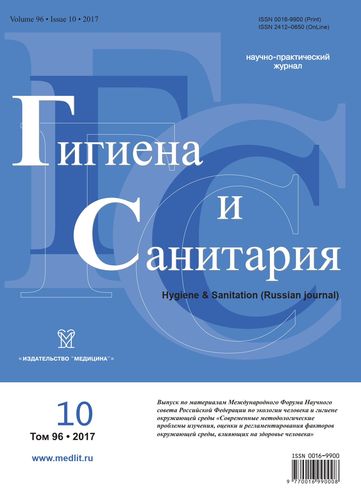The problem of the assessment of background content of heavy metal in the Kuban–Manych waterway
- Authors: Dementiev M.S.1, Dementieva D.M.1
-
Affiliations:
- North-Caucasian Federal University
- Issue: Vol 96, No 10 (2017)
- Pages: 946-949
- Section: ENVIRONMENTAL HYGIENE
- Published: 21.10.2020
- URL: https://ruspoj.com/0016-9900/article/view/640704
- DOI: https://doi.org/10.47470/0016-9900-2017-96-10-946-949
- ID: 640704
Cite item
Full Text
Abstract
In most regions of the central part of the North Caucasus, there is a persistent increase in the prevalence rate of congenital malformations of the child population and the development of other health problems. It is probable due to the fact that unlike many other regions of Russia the upper reaches of the Kuban water are contaminated by metals with a significant excess of MPCrx due to their entry from rock depths. The highest excess of manganese, copper and iron was observed. For other metals there are specific for individual waters deviations upward or downward. To date, the water in large quantities for the irrigation network is transmitted in steppe regions, feasting upon the path of additional quantities of natural contaminants, and mainly anthropogenic origin. The massive use of irrigated agriculture, the saturation of groundwater contaminants is the basis for their accumulation in the agricultural products. Thus, after drinking it is the second a local source of metals in the human body. The problem for detection of correlative relationships between pollution and human health in this case is the lack of such a target as the total MPC of pollutants in the human body, balancing entry-selection for different age, gender and other characteristics of human differences.
About the authors
Mikhail S. Dementiev
North-Caucasian Federal University
Author for correspondence.
Email: dement@mail.ru
PhD, DSci., Professor, Associate Professor, Department of Ecology and Environmental Sciences, Institute of Mathematics and Natural Sciences of the North- Caucasian Federal University, Stavropol, 355009, Russian Federation.
e-mail: dement@mail.ru
Russian FederationD. M. Dementieva
North-Caucasian Federal University
Email: noemail@neicon.ru
Russian Federation
References
- Materials to the state report «On the state sanitary and epidemiological welfare of the population in the Russian Federation for the Stavropol Territory in 2015». Stavropol’; 2015. (in Russian)
- The overall incidence of child population of the Russian Federation (0–14). Statistical data. Available at: https://www.rosminzdrav.ru (in Russian)
- Davydova S.L., Tagasov V.I. Heavy Metals Like Supertoxicants the XXI Century [Tyazhelye metally kak supertoksikanty XXI veka]. Moscow; 2002. (in Russian)
- Alekin O.A., Semenov A.D., Skopintsev B.A. Guidelines for Chemical Analysis of Surface Waters [Rukovodstvo po khimicheskomu analizu vod sushi]. Leningrad: Gidrometeoizdat; 1973. (in Russian)
- Shpeyzer G.M., Mineeva L.A. Guidelines for Chemical Analysis of Water: Manual [Rukovodstvo po khimicheskomu analizu vody: metodicheskoe posobie]. Irkutsk; 2006. (in Russian)
- Reutova T.V., Reutova N.V., Tsepkova N.L. Comparative characteristics posttechnogenic and background landscapes in the Northern Depression of the Central Caucasus. In: Proceedings of the International Conference «Sustainable Development of Mountain Areas: Problems and Prospects of Integration of Science and Education» [Materialy mezhdunarodnoy konferentsii «Ustoychivoe razvitie gornykh territoriy: problemy i perspektivy integratsii nauki i obrazovaniya»]. Vladikavkaz; 2004: 262–4. (in Russian)
- State report «On the state and Environmental Protection of the Karachay-Cherkess Republic in 2004. Administration for technological and ecological control for the Karachayevo-Cherkessia Republic». Cherkessk; 2005. (in Russian)
- Butaev A.M., Guruev M.A., Magomedbekov U.G., Osipova N.F., Magomedrasulova Kh.V., Magomedova A.D., et al. Heavy metals in the river waters of Dagestan. Vestnik Dagestanskogo nauchnogo tsentra. 2006; (26): 43–50. (in Russian)
- Vdovina O.K. Evaluation of eco-geochemical natural hazard mountainous areas while developing them as a recreational. Vestnik RUDN. Seriya Inzhenernye issledovaniya. 2009; (3): 79–82. (in Russian)
- Vorob’eva T.I., Gushchina L.P., Zhinzhakova L.Z., Reutova T.V., Cherednik E.A., Mashukov Kh.Kh. Formation of trace-element composition of river waters in the Central Caucasus. In: Materials of the Scientific-Practical Conference «Modern Fundamental Problems of Hydrochemistry and Surface Water Quality Monitoring in Russia». Rostov-na-Donu; 2009: 39–42. (in Russian)
- Shtefko Yu.Yu., Dement’ev M.S. Ecological features of formation of quality of surface water irrigation path Kuban-Manych. Izvestiya Samarskogo nauchnogo tsentra Rossiyskoy akademii nauk. 2009; 11(1): 1194. (in Russian)
- Toroyan R.A. Heavy metals in the aquatic ecosystem of the river Belaya Northwest Caucasus. In: Proceedings of the Conference Applied Aspects of Geology, Geophysics and Geo-ecology, Using Modern Information Technologies [Sbornik konferentsii prikladnye aspekty geologii, geofiziki i geoekologii s ispol’zovaniem sovremennykh informatsionnykh tekhnologiy]. Maykop; 2013: 229–36. (in Russian)
- Report on the state of the environment and nature in the Stavropol Territory in 2014. Stavropol; 2015. (in Russian)
- Dement’eva D.M., Dement’ev M.S. Background transboundary environmental water crisis tract Kuban-Manych. Gigiena i sanitariya. 2016; 95(9): 837–41. (in Russian)
- Scheme of complex use and protection of water bodies of the Kuban River basin Available at: http://www.kbvu-fgu.ru/docs7 (in Russian)
- Dement’ev M.S Hydrobiological implications and method of determining the dust pollution nival-glacial systems Kriosfera Zemli. 2016; 20(1): 26–9. (in Russian)
- Vodyanitskiy Yu.N. The standards for the content of heavy metals and metalloids in soils. Pochvovedenie. 2012; (3): 368–75. (in Russian)
- Maximum permissible concentrations of heavy metals and arsenic in food raw materials and food products. Available at: http://www.libussr.ru/doc_ussr/usr_13248.htm (in Russian)
- Maximum permissible concentration of air in populated areas. Available at: http://ecmoptec.ru/pdknasmest (in Russian)
Supplementary files









